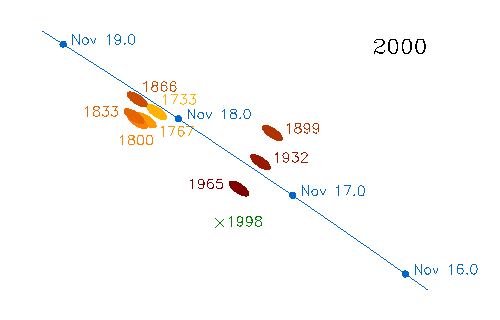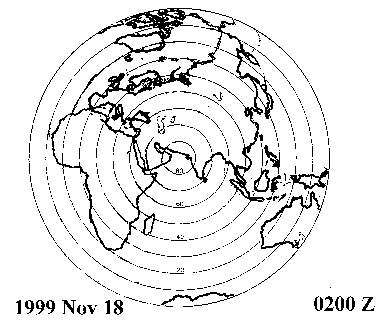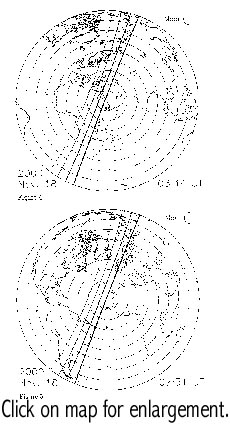
For info, see link to Asher.
The Upcoming Leonids Meteor Storms
SUMMARY - A "storm" was predicted for Europe and the Middle East in 1999, at 0208 UTC (+/- 10 minutes) on November 18.
A storm occurred, peaking at about 0205 UTC!!!
As of December 1999, the actual ZHR remains somewhat in dispute. But there seems no doubt that it was greater than 1500, possibly as much as 5000!
However, the meteors were generally small and faint, producing weaker VHF signals, with few fireballs (again, exactly as predicted). Thus, for those using forward scatter, the 1998 "fireball storm" produced better conditions, even though the ZHR was much lower.
Predictions for 2000 are much less definite than they were for 1999. A fair to good display is expected, probably with more than one peak. But for 2000, a full "storm" is much less likely. (See the 2 diagrams for 2000, showing the area of the world most likely to see the maximum meteors).
Looking ahead, 2001 and 2002 appear to again bring chances of storms. The earth will be much farther from the comet, so chances of a full storm these years are problematic. But after the success of the 1999 prediction, it would be a good idea to be available for all three of these years! (Don't expect to just wait until they come around again in 33 years, for that return of the comet is not expected to bring large storms).
In light of the success of the 1999 prediction, there will be new and revised predictions available before November 2000. This Summary paragraph has been revised and the charts for 2000 added, in order that you might be able to plan ahead. This will be removed and new predictions will be uploaded when they become available.
ORIGINAL NOTES
In 1998 there were many different predictions about whether or not the November Leonids meteor shower would produce a meteor "storm." There was no storm, but the large number of fireballs caught most by surprise. There were a few who foresaw the possibility of fireballs, but the timing of the fireball peak again caught most (but not all) by surprise.
Several individuals and groups have now (1999) done an extensive analysis of the history of the Leonids meteor storms, and they feel that they can predict whether or not we are likely to have a meteor storm, and even predict it to within a few minutes!
Here is a very brief summary of their predictions, and the basis for them. Note that the times given in this summary will not be quite the same as your shower prediction programs, etc. While these are only predictions, they may be the closest we have ever had. It is suggested that you save these notes, and also put the times and dates on your calendar. And watch for refinements after each year's shower.
Meteor showers are caused when the earth in its orbit crosses the orbit of a comet in a region where the dust particles are more dense. In years when the comet is close to the earth, it is logical to expect a larger shower. The time of the peak is expected to be approximately when the earth crosses the orbit of the comet (due to perturbations, especially by Jupiter, the times are never exact and will also vary year by year). Most (though not all) of the predictions for the 1998 Leonids shower were based upon the crossing of the comet's orbit by the earth. As Comet 55P/Tempel-Tuttle was then close to the earth in its 33-year orbit, it was hoped that a meteor "storm" would occur.
It is natural for the density of the meteorite streams to decrease with time, after their ejection from the parent comet as it passes perihelion. However, in the case of Comet 55P/Tempel-Tuttle, it is in a 5/14 resonance with Jupiter. Thus, dust ejected as the comet rounds the sun can add to pre-existing dense regions if the ejection is within a suitable initial range of semi-major axes. This resonant mechanism leads to showers that have a larger than average number of fireballs; larger particles, which produce brighter meteors, tend to have lower ejection speeds from the comet and also are not strongly dispersed by the pressure of light from the sun. They, therefore, go into orbits that are more similar to that of the comet, which is itself in resonance. If the earth crosses one of these dense streams, a brief but spectacular storm will result.
Much of the uncertainty in predicting Leonid storms in the past has been due to the fact that astronomers have traditionally relied on the comet's nodal longitude and distance to predict activity. It had been assumed (in spite of evidence to the contrary) that the cometary dust was more or less constant in density, varying from the most dense near the comet and becoming less and less dense farther away from its orbit and the comet's position in orbit. However, this did not take into account the possibility of stable dust trails in a similar orbit - trails that could, after several revolutions, become quite narrow and dense. (Perhaps these are similar to the "filaments" that some have postulated, for both Radio Amateurs and some visual observers have long said that the major showers seemed to have considerable structure in their density). The larger pebble-sized particles tend to remain for a longer time near the comet itself, as they are not pushed away by the sun's radiation pressure. It now appears that in 1998, the brilliant fireballs occurred when the Earth passed through a dense cloud of particles released by the comet in the year 1333 (or 20 revolutions ago). These larger meteoroids have kept average orbital periods very close to the comet itself, and are kept there by the 5/14 resonance with Jupiter.
Joe Rao and others had previously mentioned this possibility. Now, several individuals and groups, including Robert McNaught and David Asher, and E. D. Kondrat'eva, have analyzed the past 200 years, and have found that nearly all of the Leonids storms can be predicted to within about 15 minutes by analyzing the passage of the earth through these dust trails. These notes are taken primarily from the research of Asher, McNaught, and Joe Rao.
Leonids storms can result from two causes: close approaches to a single recent dust trail, or an encounter with the dense resonant zone. Over the next four years, the Earth should closely encounter individual dust trails at various distances. Thus, between 1999 and 2002, there appears to be an excellent chance of one or more meteor storms! In fact, each year may have several peaks, separated by several hours. One of these peaks may produce a storm. However, there is no reason to expect any further great display of fireballs as the earth will be well past this area in this and the following years.
The most likely years for storms appear to be 2001 and 2002 (Asher).
Rao puts 1999 as the most likely year for a storm.
Here is a chart of the most likely peak times and estimated ZHR's. Note that several (most?) years have more than one expected peak. (There may also be other minor peaks on most of these years; and after 1999 and especially after 2000, the predictions for the next two years should be even better).
|
TIME (UTC) |
Estimated ZHR |
Moon age |
Visible from |
Notes |
|
|
1999 Nov 18, 0208 |
1500 |
10 |
Europe, Middle East, Africa |
(Also watch Nov 18, 0100-0400 and possibly other times). Fireballs not expected! |
|
|
2000 Nov 18, 0344 |
100-5000? |
22 |
Europe, Africa |
Storm not likely. |
|
|
2000 Nov 18, 0751 |
100-5000 |
22 |
E USA, E Canada, Atlantic |
Storm not likely. |
|
|
2001 Nov 18, 1001 |
2500 |
3 |
Americas |
Possible storm at one of these times. |
|
|
2001 Nov 18, 1819 |
10000-35000 |
13 |
E Asia, W Pacific, Australia |
See note, above |
|
|
2002 Nov 19, 1036 |
25000 |
15 |
Americas |
Possible storm?? |
|
Again, notice that these predictions are based upon the earth's passing through a dense portion of a very small dust trail (Nov. 18, 0208 UTC for 1999). They are not based simply on the time of the earth's crossing of the comet's orbit (1999 Nov. 18, 0147 UTC). Thus these times will not be the same as the "standard" predictions you may have previously read.
Also, note that even though the radiant doesn't rise until about midnight local time, "earth skimmers" are possible at times when Leonids meteors would normally not be expected. These are meteoroids which skim through our atmosphere along a path nearly tangential to that of the Earth. They are seen when the shower radiant is either very near to, or just below the local horizon. Norman McLeod (AMS) comments that if the peak activity should be appreciably delayed, "...the sky ought to have a continuous show of Earth-grazing Leonids in view from the eastern states. Considering that each Earth-grazer typically lasts 3 to 6 seconds, there ought to be more than one visible at any instant for awhile."
(Note that there were very few reports of "earth skimmers" in 1999).
The map below (1999, left) shows the view of the earth as would be seen from the radiant point of the Leonids at the expected peak time. The concentric circles, centered between Arabia and India, indicate the elevation of the radiant at that time. Note that Europe would have a good radiant elevation if the peak occurs near 0200 UTC in 1999. For 2000, click on the pair of maps on the right for an enlargement. (Maps based on work by Robert H. McNaught).


Joe Rao sums up the probabilities for 1999 in this manner: "Based upon all circumstantial and empirical evidence, it would appear at first glance that the Leonids should be unusually active in 1999. However, the actual level of this activity is still open to debate. There are those like Peter Brown and Jim Jones of the University of Western Ontario who are suggesting a heavy Leonid shower for this year. Peter Jenniskens of NASA's Ames Research Center says, 'I am optimistic...we may get rates as high as 7000 per hour or so.' David Asher's study of meteor trails for three-revolution ejected particles from 55P/Tempel-Tuttle demonstrates that 1999 compares quite favorably to the one-revolution storm of 1833 and two-revolution storm of 1966. Meanwhile, there are others, like Zidian Wu and Iwan P. Williams in Great Britain, who are standing by their position that 'only a few Leonids will be seen.' Echoing [Kenneth Linn] Franklin's thoughts from 1966, I personally will only go so far as to say - with guarded optimism - that the 1999 Leonids certainly have the potential to put on an 'interesting display.' If so, much of Europe and Northern Africa apparently will have ringside seats for it [see map, above]. However,....another famous periodic shower, the Giacobinids, surprised one and all in 1998 by arriving at their maximum some 4 to 8 hours earlier than the most reliable projections had indicated. Were this to happen with this year's Leonids, it would mean that the best show would shift toward eastern Asia and Australia. If they are to peak 4 to 8 hours late, then much of North America would get a shot at them. On paper, the odds are weighed against either of these scenarios actually happening, but meteor displays do not occur on paper!"
No doubt these predictions will be further examined and refined between now and November. Watch for updates, remembering that these are only predictions and extrapolations. And please keep accurate records of the various peak times and their intensity, and forward them to the proper group. This information will allow predictions for the next few years to be greatly refined. Be sure to watch for further updates on the "Hot News" page before the November 2000 Leonids shower!
NOTE - new information, with some recent comments by Rob McNaught, on the Leonids 2000 page.

For info, see link to Asher. |
(Click here to see a diagram from 1998 and 1999).
For further reading, see WGN, the Journal of the IMO 27:2 (1999), Leonid Dust Trails and Meteor Storms; also IMO 27:3/4, Visibility of Leonid Showers in 1999-2006 and 2034, IMO 27:3/4, Anticipation: The 1999 Leonid Meteors; the November 1999 and February 2000 issues of Sky and Telescope; and the December 1999 and several 2000 issures of WGN.
Also see the pages of Asher and McNaught for their own words on the subject.
Reports from the special Leonid MAC mission to study the 1999 Leonids (still being updated).
For some 1999 reports, see NASA's early report or the IMO, NAMS, etc. These Web sites (linked from the "Hot News" and "URLs" pages).
07/99, rev 09/99.